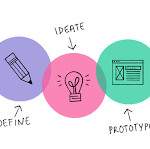When design principles are applied to strategy and innovation the success rate for innovation dramatically improves. Design-led companies such as Apple, Coca-Cola, IBM, Nike, Procter & Gamble and Whirlpool have outperformed the S&P 500 over the past 10 years by an extraordinary 219%, according to a 2014 assessment by the Design Management Institute.
Great design has that “wow” factor that makes products more desirable and services more appealing to users.
Due to the remarkable success rate of design-led companies, design has evolved beyond making objects. and apply design principles to the workplace itself. Design thinking is at the core of effective strategy development and organizational change.
“Design-thinking firms stand apart in their willingness to engage in the task of continuously redesigning their business…to create advances in both innovation and efficiency—the combination that produces the most powerful competitive edge.”
—Roger Martin, author of the Design of Business
“Engineering, medicine, business, architecture, and painting are concerned not with the necessary but with the contingent—not how things are but how they might be—in short, with design…Everyone designs who devises courses of action aimed at changing existing situations into preferred ones.”
You can design the way you lead, manage, create and innovate. The design way of thinking can be applied to systems, procedures, protocols, and customer/user experiences. The purpose of design, ultimately, in my view, is to improve the quality of life for people and the planet.


